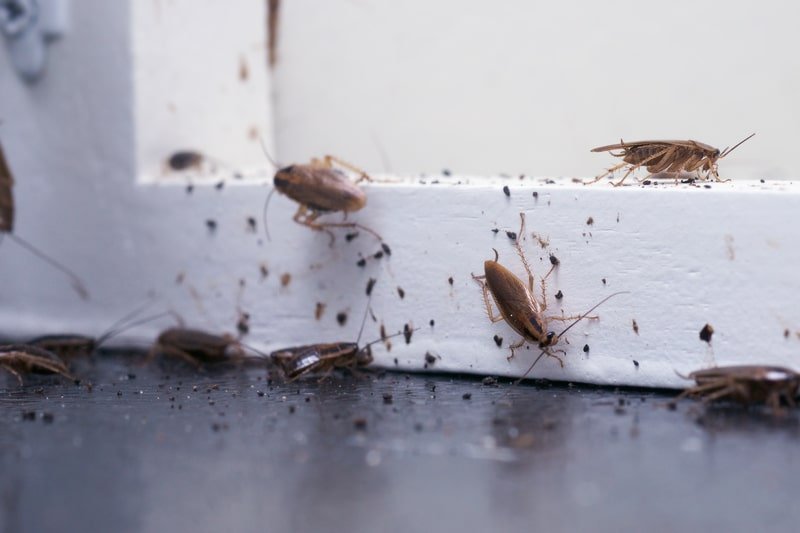Have you ever wondered how the experts tackle the persistent problem of roaches? Discover the secrets behind the efficient methods used by professionals to eradicate these unwelcome pests from your home. From advanced insecticides to strategic trapping techniques, this article provides an insightful glimpse into the world of pest control, offering practical tips and solutions to ensure a roach-free environment.


Inspection and Identification
Identifying the Species of Roaches
When dealing with a roach infestation, it is crucial to identify the specific species of roaches involved. This step is important because different species require different treatment methods and strategies. The most common roaches found in homes and buildings include German cockroaches, American cockroaches, Oriental cockroaches, and Brown-banded cockroaches. By accurately identifying the species, professionals can tailor their treatment approach to effectively eliminate the roaches.
Assessing the Infestation Level
Determining the severity of the infestation is vital in developing an appropriate treatment plan. Professionals will inspect the affected areas to assess the size of the infestation and identify the hotspots where roaches are commonly found. This allows them to better understand the extent of the problem and prioritize treatment efforts for maximum effectiveness.
Identifying Entry Points and Harborage Areas
Roaches can enter buildings through various entry points such as cracks, crevices, gaps in windows/doors, and utility openings. Identifying these entry points is crucial in preventing future infestations. Additionally, roaches tend to hide in harborage areas such as dark corners, beneath appliances, and within wall voids. By pinpointing these hiding spots, professionals can target their treatment and elimination efforts more effectively.
Determining Potential Food and Water Sources
Roaches are attracted to readily available food and water sources, making it necessary to identify and eliminate these factors. Professionals will carefully inspect areas like kitchens, trash cans, and food storage areas to identify potential sources of nourishment for the roaches. By removing or securely storing food, cleaning surfaces regularly, and fixing water leaks or moisture problems, professionals can reduce the attractiveness of the environment for roaches.
Sanitation and Exclusion
Eliminating Food Sources
One of the most essential steps in roach control is removing any accessible food sources. Professionals will advise you to keep your kitchen clean and free from food debris, wash dishes promptly, and store food in airtight containers. By denying roaches access to their primary sustenance, their survival and reproduction will be hindered significantly.
Reducing Access to Water
Roaches also require a water source to survive, so it is crucial to minimize their access to water. Fixing any leaks or drips in plumbing, ensuring proper drainage, and eliminating areas of excess moisture will help reduce their attraction to your home or building. By denying them water, roaches will be deprived of a critical element necessary for their survival.
Sealing Cracks and Crevices
Roaches can squeeze through incredibly small openings, so sealing cracks and crevices is an essential step in preventing their entry. Professionals will carefully inspect the building and recommend sealing gaps in doors, windows, walls, and foundations. By denying roaches any potential entry points, you can significantly reduce the likelihood of future infestations.
Repairing Plumbing Leaks
Roaches are often attracted to areas of moisture and water leaks provide them with just that. It is crucial to fix any plumbing leaks promptly to eliminate the roaches’ water source. Professionals will check both visible and hidden plumbing areas for leaks and recommend repairs or replacements as needed. By addressing plumbing issues, you effectively eliminate a critical element that roaches require to survive and reproduce.
Removing Clutter and Debris
Roaches thrive in cluttered environments, as it provides them with ample hiding places and protection. Professionals will recommend decluttering and removing unnecessary items from your living or working spaces. By minimizing clutter and debris, you reduce the number of potential harborage areas for roaches, making it more difficult for them to establish a presence in your home or building.
Chemical Treatment
Choosing the Appropriate Insecticide
When roach infestations are severe or persistent, professionals may suggest the use of insecticides to effectively eliminate these pests. However, it is crucial to choose the appropriate insecticide for the specific roach species and the environment in which they are present. Different insecticides have varying degrees of effectiveness and residual activity, so professionals will select the most suitable product for your situation.
Using Baits and Gel Formulations
Baits and gel formulations are commonly used by professionals to control roach populations. These products contain attractants and insecticides, effectively luring roaches to consume the bait or come into contact with the gel. Baits can be placed in strategic locations such as under sinks or behind appliances, while gel formulations can be applied in cracks and crevices. By using these targeted applications, professionals can directly impact roach populations and eliminate them at the source.
Implementing Residual Sprays and Dusts
Residual sprays and dusts are another chemical treatment method used by professionals to control roach infestations. These products are applied to surfaces where roaches frequent, such as baseboards, wall voids, and cabinets. The residual activity of these treatments ensures that roaches that come into contact with treated surfaces will be affected, even after the initial application. Professionals will consider the specific needs of your situation and determine whether residual sprays or dusts are necessary for effective control.
Applying Insect Growth Regulators (IGRs)
Insect Growth Regulators (IGRs) are chemical compounds used to disrupt the reproduction and growth of roaches. Professionals may recommend the use of IGRs to target juvenile roaches and inhibit their development into adult roaches. By preventing roaches from reaching adulthood and reproducing, the population can be effectively controlled. IGRs are often combined with other treatment methods for maximum effectiveness.
Coordinating Treatment with Pest Control Operators (PCOs)
In situations where roach infestations are severe or persist despite DIY efforts, it may be necessary to coordinate treatment with professional pest control operators. These professionals have the knowledge and experience to implement integrated pest management (IPM) strategies and effectively eliminate roaches. They can assess the specific needs of your situation, recommend treatment plans, and apply targeted treatments to eliminate roaches more comprehensively.
Heat and Cold Treatment
Utilizing Heat Treatment
Heat treatment is a non-chemical method used to eliminate roaches by raising the temperature of the affected area to lethal levels. Professionals may use specialized equipment to heat infested rooms or buildings, effectively killing roaches and their eggs. Heat treatment is particularly useful for areas where chemical treatments may not be suitable, such as sensitive environments or situations where chemical exposure is a concern. By utilizing heat treatment, professionals can effectively control roach populations without relying on traditional insecticides.
Implementing Cold Treatment
In contrast to heat treatment, cold treatment involves lowering the temperature of the affected area to a level that is lethal to roaches. This method is less commonly used than heat treatment but can be effective in certain situations. Professionals may use specialized equipment to reduce the temperature, effectively freezing the roaches and causing their demise. Cold treatment can be an alternative approach for sensitive environments or situations where heat treatment may not be feasible.


Biological Control
Introduction of Natural Predators
Biological control involves the introduction of natural predators or parasites that feed on roaches, effectively reducing their population. While this method is not commonly used for residential or commercial properties, it can be effective in certain circumstances. Professionals may introduce predators such as lizards or spiders that naturally consume roaches. However, this approach requires careful consideration and monitoring to ensure the introduced predators do not become pests themselves or disrupt the local ecosystem.
Using Nematodes
Nematodes are microscopic worms that can be effective in controlling roach populations. These organisms can infect and kill roaches from within, significantly reducing their numbers. Professionals may recommend the application of nematodes to targeted areas where roaches are prevalent. The nematodes then seek out and infect the roaches, ultimately leading to population control. This naturally occurring biological control method can be a viable alternative to traditional chemical treatments.
Implementing Disease-Causing Bacteria
Another biological control method involves the use of disease-causing bacteria to control roach populations. Professionals may utilize specific strains of bacteria that are safe for humans and pets but lethal to roaches. These bacteria are typically ingested by the roaches and gradually cause infections or diseases, ultimately leading to their demise. This method offers a more environmentally friendly approach to roach control, as it does not rely on harsh chemicals.
Preventive Measures
Maintaining Cleanliness and Hygiene
One of the most effective ways to prevent roach infestations is by maintaining cleanliness and hygiene in your living or working space. Regularly cleaning your kitchen, wiping down surfaces, and promptly disposing of trash can help deter roaches from entering your space. By denying them food and water sources, you make your environment less attractive to roaches in the first place.
Storing Food Properly
Proper food storage is crucial in preventing roach infestations. Professionals recommend storing food in airtight containers and keeping them off the floor. This minimizes the availability of food sources for roaches and makes it more difficult for them to access stored food. By taking these simple precautions, you can greatly reduce the risk of attracting roaches into your home or business.
Regularly Inspecting and Monitoring
Regular inspections and monitoring are essential in detecting early signs of roach activity. Professionals suggest periodic checks in areas prone to infestations, such as kitchens, bathrooms, and basements. Look for fecal droppings, shed skins, and any signs of roach movement. By catching infestations early, you can take immediate action and prevent them from escalating.
Sealing Entry Points
An effective way to prevent roach infestations is to seal off potential entry points. Inspect your home for cracks, crevices, and gaps around doors, windows, and utility openings. Professionals recommend using caulk or sealant to close these openings, preventing roaches from entering your living or working spaces. By sealing off their entry points, you significantly reduce the risk of roach infestations.
Ensuring Proper Waste Disposal
Proper waste disposal is critical in roach prevention. Ensure that trash cans have tight-fitting lids and empty them regularly. Professionals advise against leaving garbage bags or bins unattended for extended periods. By eliminating a readily available food source, you discourage roaches from establishing themselves near your property.


Professional Pest Control Services
Hiring Licensed Exterminators
If you are facing a severe or persistent roach infestation, it is advisable to seek the assistance of licensed exterminators. These professionals have the expertise, knowledge, and tools necessary to effectively eliminate roaches from your property. They are trained in the latest treatment methods and can develop a customized plan based on the specific needs of your situation.
Understanding Treatment Plans
Professional pest control services will provide you with a detailed treatment plan tailored to your roach problem. This plan will outline the steps to be taken, the expected timeline, and the methods and products to be used. Professionals will explain the treatment plan in a clear and understandable manner, ensuring that you are informed and comfortable with the proposed approach.
Scheduling Regular Inspections
Regular inspections are a crucial part of professional pest control services. These inspections ensure that any reinfestation or new infestation is detected early, allowing for prompt action. Professionals will recommend a frequency for these inspections based on the severity of your previous infestation and the risks involved. By scheduling regular inspections, you can maintain a roach-free environment and catch any signs of activity before they escalate.
Following Recommendations
To ensure the effectiveness of professional pest control services, it is essential to follow the recommendations provided by the experts. These recommendations may include steps for ongoing maintenance, such as sanitation practices and exclusion methods. By diligently following these recommendations, you can maximize the results of the treatment and create an environment less conducive to roach infestations.
Integrated Pest Management (IPM)
Using a Comprehensive Approach
Integrated Pest Management (IPM) is an approach that emphasizes a comprehensive and strategic method of pest control. Professionals employ a range of control techniques and materials, considering the specific needs of each situation. By utilizing multiple strategies in combination, professionals can achieve long-term, sustainable results in roach control.
Implementing Monitoring and Thresholds
Monitoring plays a vital role in IPM. Professionals set thresholds to determine when action needs to be taken. By regularly monitoring the area for signs of roach activity and assessing the population levels, professionals can determine if intervention is necessary. This proactive approach allows for timely and targeted treatment, minimizing the potential for larger infestations.
Applying Combination of Techniques
IPM relies on the application of multiple techniques to control roach populations effectively. Through a combination of sanitation practices, physical exclusion, chemical treatments, and biological control methods, professionals can create an integrated approach tailored to the specific roach problem. The combination of techniques allows for a more comprehensive and effective control strategy.
Emphasizing Non-Chemical Methods
IPM puts a strong emphasis on non-chemical methods of pest control. While chemical treatments may be necessary in some situations, professionals strive to minimize their use. Instead, they prioritize practices such as sanitation, exclusion, and biological control. This approach reduces potential risks associated with chemical treatments and promotes a more environmentally friendly approach to roach control.
Evaluating and Adjusting Strategies
IPM is a dynamic process that requires regular evaluation and adjustment of control strategies. Professionals will monitor the effectiveness of the chosen methods and make necessary modifications based on the results. By continuously evaluating and adjusting strategies, professionals can ensure the most effective and efficient control of roach populations.


Safety Precautions
Wearing Protective Gear
When dealing with roach control, professionals prioritize safety measures, including wearing appropriate personal protective equipment (PPE). This may include gloves, masks, and coveralls to minimize exposure to chemicals or allergenic particles. By following safety protocols, professionals can reduce the risks associated with roach control efforts.
Taking Proper Chemical Handling Measures
For professionals using chemical treatments, proper handling of the substances is of utmost importance. They will carefully read and follow the instructions provided by the manufacturer to ensure the safe and effective use of the products. This includes measures such as diluting chemicals correctly, utilizing proper equipment for application, and avoiding unnecessary contact with skin or eyes.
Avoiding Contamination of Food and Surfaces
Professionals are vigilant in ensuring that chemicals or treatments do not contaminate food or surfaces. When applying insecticides or baits, they will take measures to prevent any possible contact with food items and keep treated areas separate from food preparation or storage areas. By maintaining this separation, professionals ensure the safety and well-being of occupants and reduce the risk of ingestion or accidental exposure.
Protecting Children and Pets
Professionals prioritize the safety of children and pets during roach control procedures. Measures are taken to restrict access to treated areas until the products have dried or settled. Professionals may also recommend temporarily relocating pets during treatments to prevent any potential harm. By implementing these precautions, professionals ensure the well-being of vulnerable members of your household.
Follow-Up and Monitoring
Evaluating the Effectiveness of Treatment
After implementing roach control measures, professionals will assess the effectiveness of the treatment. This evaluation involves checking for signs of roach activity, monitoring population levels, and assessing whether the treatment goals have been achieved. If necessary, additional treatments or adjustments to the control strategy may be recommended based on the evaluation results.
Implementing Ongoing Monitoring
To maintain a roach-free environment, ongoing monitoring is essential. Professionals will schedule follow-up visits to inspect the property, ensuring that the infestation has been adequately controlled and monitoring for any signs of new activity. By implementing ongoing monitoring, professionals can detect and address reinfestations early, preventing them from becoming significant problems.
Identifying Reinfestation Signs
Reinfestations can occur if roaches are reintroduced or if previously untreated populations resurge. Professionals will train you to identify signs of early reinfestation, such as fecal droppings, shed skins, or live roaches. By being vigilant and knowledgeable about these signs, you can take immediate action or alert professionals to address any reinfestation promptly.
Taking Immediate Corrective Action
Upon identifying signs of reinfestation or continued activity, it is important to take immediate corrective action. Contacting professionals and following their recommendations is crucial to control the infestation and prevent it from spreading further. By promptly addressing any issues, you can maintain a roach-free environment and minimize the potential for recurring infestations.
In conclusion, professionals have a variety of methods and strategies at their disposal when it comes to eliminating roach infestations. Through comprehensive inspections, identification of roach species, sanitation and exclusion practices, chemical treatments, biological control methods, and ongoing monitoring, professionals can effectively rid properties of roaches. By following their recommendations, homeowners and businesses can achieve long-term roach control and create a healthier, more comfortable living or working environment. Stay proactive and don’t hesitate to seek professional assistance if needed – together, we can successfully eradicate roaches and keep our spaces clean and pest-free.
Your Expert in Animal Control and Extermination. Trust our experience for humane, effective pest management, protecting your property and ensuring peace of mind with Michael S.





